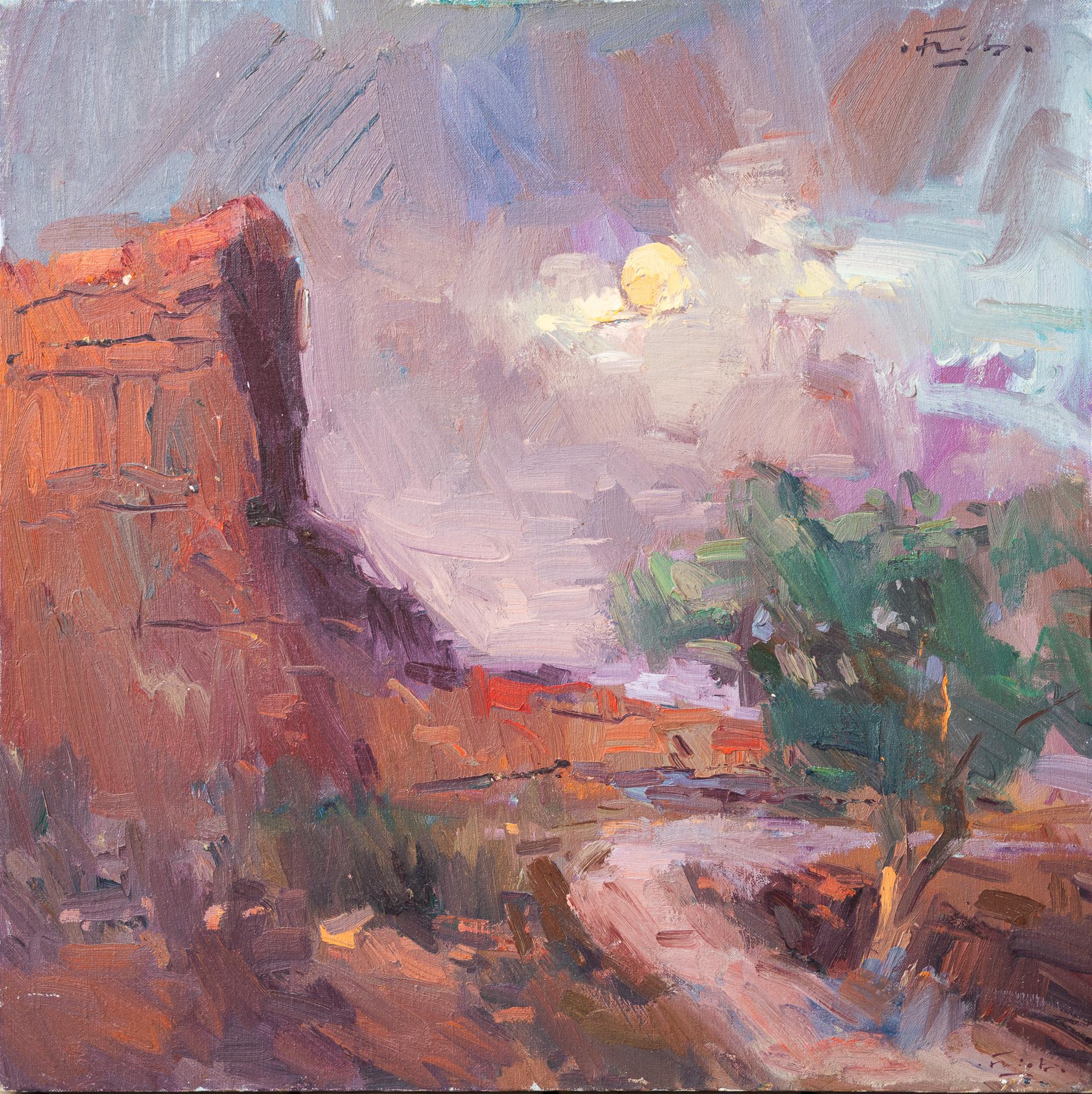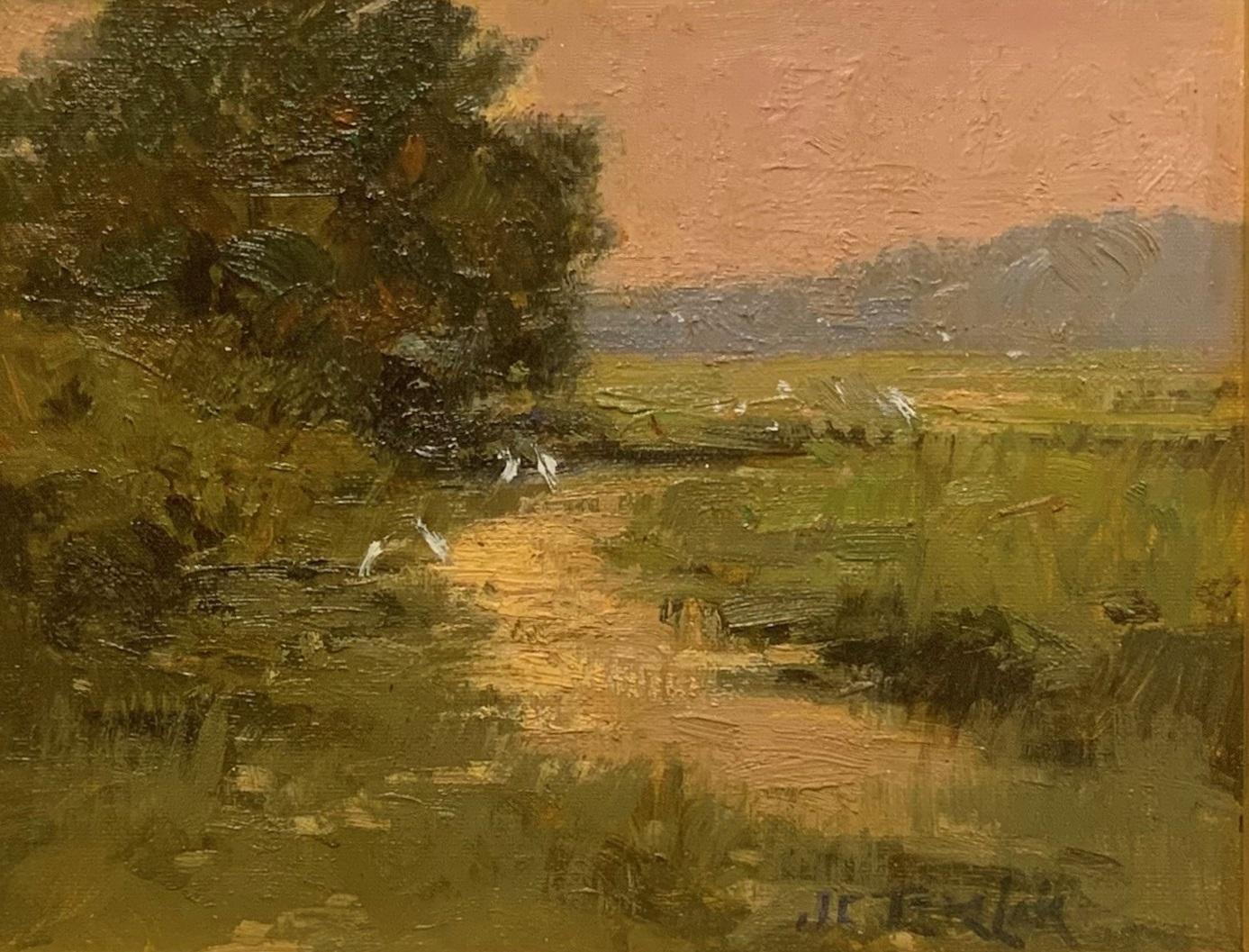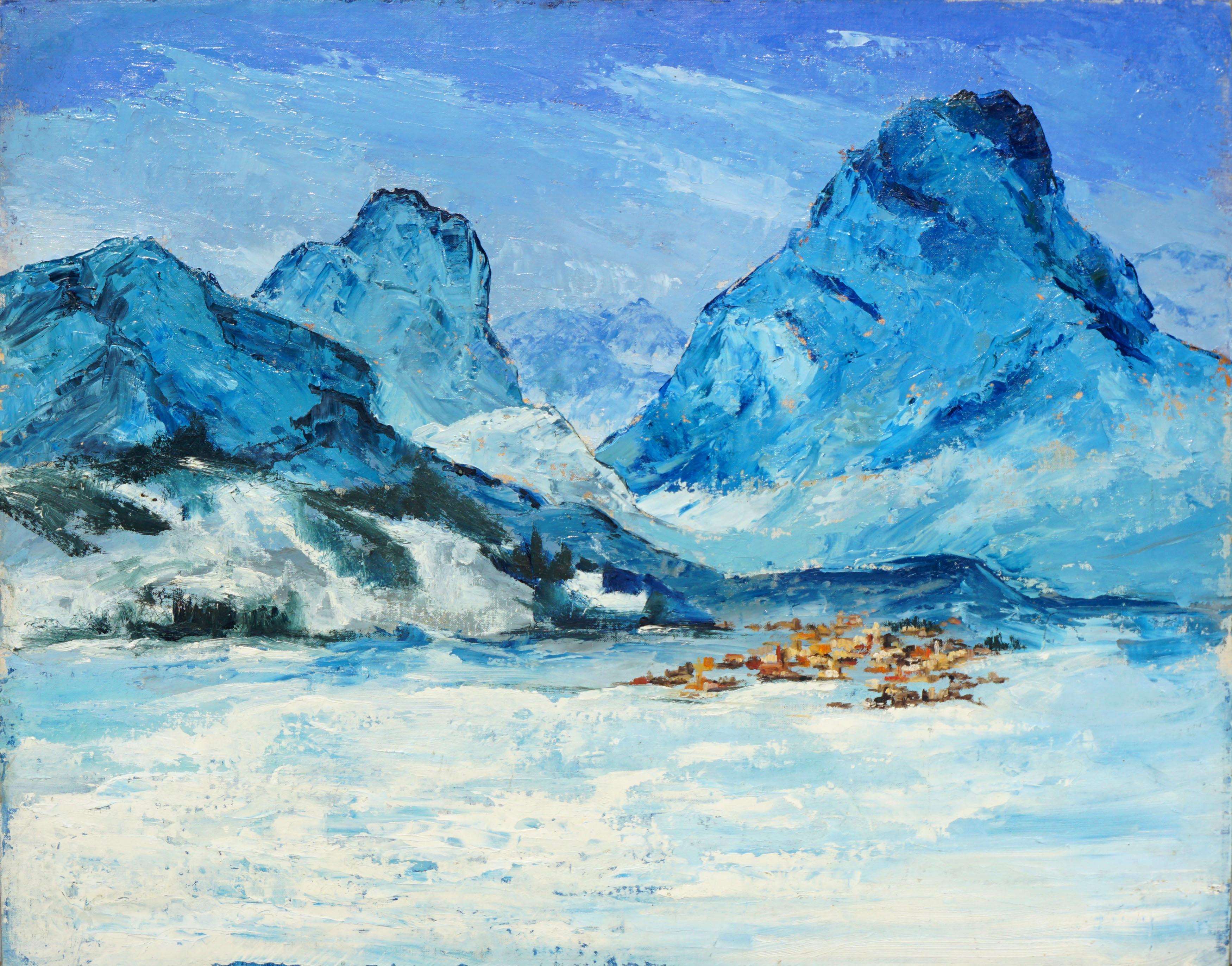Items Similar to "View of New York Harbor, Staten Island Ferry, " Gustave Wolff, Impressionism
Want more images or videos?
Request additional images or videos from the seller
1 of 8
Gustave Wolff"View of New York Harbor, Staten Island Ferry, " Gustave Wolff, Impressionism
About the Item
Gustav (Gustave) Wolff (1863 - 1935)
View of New York Harbor from the Staten Island Ferry
Oil on canvas
16 x 12 inches
Signed lower right
In the Autumn of 1913, the German Association for Culture featured the work of Gustave Wolff (1863- 1935) in one of the artist's first New York City exhibitions held at the Yorkville Library. The New York Times stated, "Mr. Wolff is better known in the West and in Europe than in New York, and this is the first opportunity to see a collection of his work in this city."
A painter of Impressionist and Tonalist landscapes, Wolff arrived in New York most likely within the year prior to this exhibition. However, by the 1910's, the American art scene was witnessing a shift toward modernism. American Impressionism, which began as a rebellion against conservative academic artistic standards, was now endorsed by the National Academy of Design, while urban realism and abstraction became the new form of artistic protest. Having matured artistically around the turn of the century, just before this major shift, Gustave Wolff remained committed throughout his career to capturing the everyday poetry of the rural and urban landscape.
Raised in St. Louis after his family immigrated to the United States in 1866 from Berlin, Germany, Wolff studied at the St. Louis School of Fine Arts and with Paul Cornoyer, F. Humphrey Woolrych, and Frederick Oakes Sylvester. By 1901, Wolff had become the preeminent painter in St. Louis and a frequent exhibitor with the St. Louis Artists' Guild, the Society of Western Artists, and the Two-By-Four Club, leading one critic to write:
"If the maxim that artists are born, not made, be true, it applies most decidedly to Mr. Wolf [sic], whose training was as unsystematic and interrupted as his career was subjected to influences most unfavorable to his artistic development. But in spite of all difficulties he has forged his way to the front until his work has become of such importance that an exhibit of Western Artists would be incomplete without his admirable landscapes."
By 1906, Wolff was considered one of the leading landscape painters in St. Louis. It was in that year that two of his paintings were accepted to the Paris Salon. One humorous and rather cynical article discussed Wolff's success:
"Gustav[sic]Wolff of St.Louis,who does the fine art decoration of the billboards behind which you threw the tin cans this spring, has just had a bit of luck . . . [T]he people who sniffed when they saw Mr. Wolff sitting under a screen and daubing the billboards are surprised to learn that two pictures of his have now been accepted by and are hung conspicuously in the Paris salon. He is known in Paris as a landscape painter of ability and exquisite workmanship."
Like many American painters in this period, Wolff traveled to the Netherlands for further artistic training. In the late nineteenth century, there was a growing fascination in the United States with Dutch Art of the seventeenth-century, which became widely collected. At the same time, more affordable works by contemporary Dutch artists working in The Hague were increasingly collected especially by patrons in St. Louis.
Guided by Dutch Old Master depictions and romanticized literary descriptions, American artists visiting the Netherlands produced images of domesticity, strong communities, and religious values. Having trained in St. Louis, where Dutch artistic influence was strong, Wolff had already adopted the loose, confident brush- work and atmospheric effects that characterize Dutch painting.
When Wolff arrived in New York City in the early 1910s, he would have encountered the group of urban realist painters who dominated the New York art scene. The Eight, or the artists of the Ashcan School, were known for their frank, un-idealized depictions of common people and the industrial energy of New York. Their works presented the appealing, yet gritty reality of this urban environment and the transitory nature of the city. Wolff's paintings of everyday life often depict scenes of leisure, typical of the Impressionist manner. However, expressing the character of the modern metropolis was also a significant statement of his work.
Wolff's light-filled images such as Washington Heights Bridge, New York; and Approaching the Wheelock Mansion, West 160th Street, New York express the joy of leisure and relaxation that was sought amid the density and grittiness of New York. Like the paintings of American Impressionist William Merritt Chase, who had spent the early 1870's active in the St. Louis art scene, and who was considered one of the most important artists and teachers in New York by the turn of the century, Wolff's scenes of urban leisure are populated by New York's fashionable elite.
Approaching the Wheelock Mansion, West 160th Street, New York depicts well dressed New Yorkers walking along a path that cuts neatly through a field, the lushness of which is enhanced by Wolff's loose and rapid application of vibrant tones of green. Wheelock Mansion was built in the 1860's in Audubon Park by William A. Wheelock and remained an important monument to Victorian style architecture amid the rapidly changing city until its demolition in 1939. Wolff's meditation on this fleeting moment of urban life and the anonymity of the figures on the path can easily be compared to the Ashcan artists' illustration of interactions between strangers in New York's public spaces.
In contrast to his scenes of leisure, Wolff also produced paintings of New York's commercial activity. Typical of the Impressionist mode, A Winter Day, 79th Street Boat Basin, New York displays Wolff's mastery of color and light effects in the lavender and orange clouds juxtaposed against the crisp blue sky, and the rippled shadows of the boats on the water.
Wolff's confidence and control is revealed in the sweeping brush- strokes of the water and the rough texture of the sky, demonstrating the influence of artists like Chase and John Singer Sargent. His grittier scenes reveal the industrial activity along the shores of New York. In Harlem River Factories, New York, Wolff balances the flourish of Impressionist brushstrokes in the bright white clouds with the browns and grays of the murky water. The artist has noticeably omitted any figures from this image, instead focusing on the stark beauty of this commercial waterfront. A decade after his arrival in New York, Wolff continued to exhibit his river and harbor scenes to favorable reception from the press.
- Creator:Gustave Wolff (1863 - 1935, American)
- Dimensions:Height: 22 in (55.88 cm)Width: 18 in (45.72 cm)
- Medium:
- Movement & Style:
- Period:
- Condition:
- Gallery Location:New York, NY
- Reference Number:1stDibs: LU1841210505942
About the Seller
5.0
Platinum Seller
These expertly vetted sellers are 1stDibs' most experienced sellers and are rated highest by our customers.
Established in 2021
1stDibs seller since 2022
63 sales on 1stDibs
Typical response time: <1 hour
- ShippingRetrieving quote...Ships From: Larchmont, NY
- Return PolicyA return for this item may be initiated within 3 days of delivery.
More From This SellerView All
- "The Green Parasol, " Henry Hannig, American Impressionist, Woman in Beach SceneBy Henry HannigLocated in New York, NYHenry Charles Hannig (1883 - 1948) The Green Parasol Oil on canvas mounted on board 6 x 7 3/4 inches Provenance: R.H. Love Galleries, Chicago, Illinois Private Collection, Lake Orion, Michigan Hannig, born in Hirschberg, Germany on 27 February 1883, came to America with his parents at the age of seven. He attended school in the southwest suburbs before the family settled in Chicago. Young Henry enrolled in the Chicago Academy of Fine Arts where Lawton Parker became his mentor. He made ends meet by working in industrial design and illustration. By 1908 he was a pupil in the School of the Art Institute of Chicago where students followed the traditional European drawing curriculum, beginning with the copying of master engravings and drawing after plaster casts, then concentrating on the nude figure. Students worked toward the goal of winning various academic prizes. One of Hannig's fellow students was Louis Ritman...Category
1910s American Impressionist Figurative Paintings
MaterialsCanvas, Oil, Board
- "Wellfleet, Cape Cod, " Gerrit Beneker, American Impressionism, ProvincetownBy Gerrit BenekerLocated in New York, NYGerrit Beneker (1882 - 1934) Wellfleet, Cape Cod, Massachusetts, New England, 1926 Oil on canvas 20 x 16 inches Signed, titled, and dated lower left Provenance: Louis H. Barnett, Fort Worth, Texas In 1905, Gerrit Beneker began his art career as an illustrator. He married Flora Judd, his high school sweetheart from Grand Rapids and they moved to Brooklyn, NY. Gerrit's early passion was to create an art that would inspire and provide honor to the workingman. As such, he had no interest in painting portraits of pretty women, which were so often seen on the magazine covers of the day. Rather he wanted to seek out workingmen on the bridges, tunnels and skyscrapers of NYC, and paint them in their environments. He completed over 150 magazine covers, numerous ads including many for Ivory Soap...Category
1920s American Impressionist Landscape Paintings
MaterialsOil, Canvas
- "Frosty Morning, " Jonas Lie, American Impressionist Winter Snow Landscape SceneBy Jonas LieLocated in New York, NYJonas Lie (1880 - 1940) Frosty Morning, Adirondacks, circa 1925 Oil on canvas 40 x 50 inches Signed lower left Provenance: Samuel and Ileen Campbell Wright ...Category
1920s American Impressionist Landscape Paintings
MaterialsCanvas, Oil
- "Springtime Landscape" William Anderson Coffin, American Impressionism BarbizonBy William Anderson CoffinLocated in New York, NYWilliam Anderson Coffin (1855 - 1925) Springtime Landscape, circa 1910 Oil on canvas 30 x 24 inches Signed lower right Landscape and figure painter William Anderson Coffin was born...Category
1910s American Impressionist Landscape Paintings
MaterialsCanvas, Oil
- "Spanish Mission in Florida, " Anthony Thieme, Cape Ann ImpressionistBy Anthony ThiemeLocated in New York, NYAnthony Thieme (1888 - 1954) Spanish Mission, Florida Oil on canvas 25 x 30 inches Signed lower left; titled on the reverse Anthony Thieme was born in...Category
Early 20th Century American Impressionist Landscape Paintings
MaterialsCanvas, Oil
- "Road to Provincetown, " Henry MacGinnis, Massachusetts LandscapeBy Henry Ryan MacGinnisLocated in New York, NYHenry Ryan MacGinnis (1875 - 1962) Road to Provincetown, 1924 Oil on canvas 25 x 30 inches Signed lower right; titled and dated on the stretcher Housed in a Stanford White Newcomb-Macklin frame. Exhibited: Trenton, New Jersey, School of Industrial Arts Provincetown by Professor MacGinnis, 1924. Henry Ryan MacGinnis, 1875-1962, was born in Indiana and began his art studies under the eminent Hoosier artists T.C. Steele, J.O. Adams and William Forsyth. One of his earliest exhibitions was in 1896, when he showed his work with other notable Hoosier artists such as T.C. Steele, J. Ottis Adams...Category
1920s American Impressionist Landscape Paintings
MaterialsOil, Canvas
You May Also Like
- "Moon Over Monument Valley"Located in Austin, TXAn American Impressionist depiction of a moonlit night in Monument Valley, Arizona. It features a palette of purple, pink, and dark blue. Artist: Guido Frick...Category
21st Century and Contemporary American Impressionist Landscape Paintings
MaterialsCanvas, Oil
- Dmitri Wright - Petite Mind Meadow - Opus Three, Painting 2024By Dmitri WrightLocated in Greenwich, CTAbout the artist: As an American artist, Wright’s travels have taken him to paint and/or teach throughout the United States and visiting over a dozen National Park sites in addition...Category
2010s American Impressionist Abstract Paintings
MaterialsCanvas, Paint, Oil
- EgretsBy John TerelakLocated in Greenwich, CTAmerican, b. 1942 John Charles Terelak is recognized as one of America's finest living impressionists. Born in Boston, Massachusetts, he received formal art instruction at the Vespe...Category
Early 2000s American Impressionist Landscape Paintings
MaterialsCanvas, Oil
- Manayunk, Regional American Winter Cityscape by Pennsylvania ImpressionistBy Giovanni MartinoLocated in Doylestown, PA"Manayunk" is a 8 x 12 inches, oil on canvas, regional, winter cityscape by Pennsylvania Impressionist painter Giovanni Martino. Manayunk is a suburb of Philadelphia, Pennsylvania. The painting is signed "Giovanni Martino" in the lower right. The following is from Babette Martino, daughter of the artist: Giovanni Martino, National Academy of Design* member, was born on May 1, 1908 in Philadelphia PA where all seven brothers and one sister, Filomina, Frank, Antonio, Albert, Ernest, Giovanni, Edmond, and William became painters. They were under the tutelage of their eldest brother, Frank, who in the late 1920s, founded the first commercial art studio, Martino Studios, at 27 South 18th Street. Besides studying with his two eldest brothers, Giovanni also studied with Albert Jean Adolph at La France Institute, The Pennsylvania Academy of the Fine Arts, The Graphic Sketch Club, and Spring Garden Institute in Philadelphia. In his mid teens he accompanied his two eldest brothers to New Hope searching for subjects to paint. In the 1930s, he also started to paint in Manayunk, a hilly mill town along the Schuylkill River. At this time he signed his paintings M. Giovanni. These colorful impressionistic works proceeded more thinly painted dramatically poetic street scenes of the mill town. These images developed into impasto laden oils in the 1960's with some of the paintings worked with a palette knife. In Manayunk, he was a common sight on the streets and sidewalks, painting on-the-spot with his wife, Eva Marinelli...Category
Early 20th Century American Impressionist Landscape Paintings
MaterialsOil, Canvas
- Seascape with Flock of DucksLocated in Soquel, CATranquil seascape with a large flock of migrating Redhead ducks in flight by California artist Dan Findlay (American, 20th Century). Signed "Dan Findlay" lower right. Presented in a ...Category
1970s American Impressionist Landscape Paintings
MaterialsCanvas, Oil, Cardboard
- Mid Century Mountain Landscape of the MatterhornLocated in Soquel, CAWonderful palette knife impasto painting of the Matterhorn from the Italian side with Breuil-Cervinia in forefront by Northern California artist Beatrice Ash...Category
1960s American Impressionist Landscape Paintings
MaterialsCanvas, Oil, Cardboard
Recently Viewed
View AllMore Ways To Browse
New York Boats
Antique St Louis
Antique New York Painting
Antique Frames New York
New Arrivers
New Arrives
Winter In New York
New York Winter
Impressionism Paris
New York Bridge Painting
New York Harbor
New York Winter Painting
Antique Boats Of America
New York Harbor Painting
20th Century Impressionism Paintings
Art New Arrivals
New York City Winter
Victorian New York




